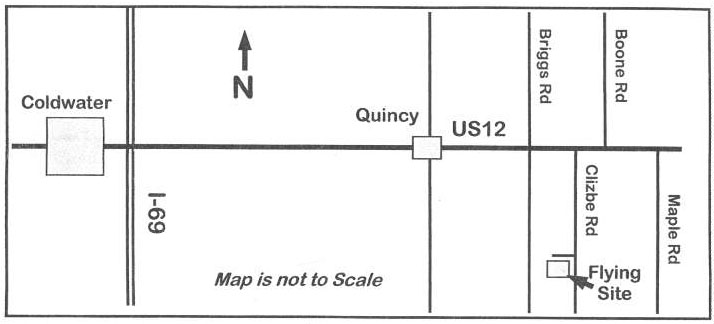|
EFO Meeting WEDNESDAY Feb. 9
The February meeting will be on a WEDNESDAY. It will be at Ken Myers's house, starting at 7:30. Everyone with an interest is welcome. See you then!
Ampeer Article About Charger's Voltage Measurement
From Camille Goudeseune cog@illinois.edu
Dave,
Thank you for your meticulous-yet-accessible article in the December 2010 Ampeer. I'm taking a break from my own monthly attempts to educate aeromodelers, but when I resume, this article will be a good example for me to revamp my style to something more accessible.
(Also, thanks again for your advice back when I started RC in 2001 with a few of your 9-cell NiMH packs!)
Return to "What's In This Issue"
Model Builder Magazine on DVD - Update
By Ken Myers
Since I always loved Model Builder Magazine, I sent Roland Friestad my $75 check and in short order received my Model Builder DVD's. The disks contain 295 issues starting with Vol. 1, No. 1 for Sept.-Oct. 1971.
Can you say, "TREASURE TROVE?"
Serendipity had me open the December 1986 issue on Volume 2 first. The beautifully digitized cover of an old timer greeted me and pleasant memories rushed through my mind. Ah, yes, I remember this issue! The inside cover ad was for an Airtronics vehicle radio system and the first page was an ad for Leisure.
Leisure was started by Roland Boucher when he broke away from his brother Bob at Astro Flight.
The ad is amazing. Remember, this is December 1986! The ad features the Leisure electrically powered Playboy and the Wasp sport plane as well as brushed motors and a charger. A photo shows two guys and a young man at a soccer field with the Playboy. The men are dressed in slacks, shirts and ties and part of the text reads, "Leisure introduces lunch hour R/C flying".
The ad text continues, "When you own a Leisure electric flight system, your R/C flying isn't limited to weekend trips to a remote flying site. Now any park, field or vacant lot becomes your flying site, anytime, anywhere, even lunch hour in the city!"
How prophetic was that?!?
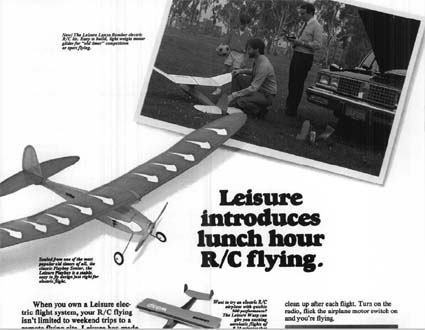
I chose 1986 because that was the year I went totally 'electric power'.
A look at the table of contents reminded me of my favorites;
Dear Jake - Advice for the Propworn, an extremely tongue-in-cheek advice column
Electronics' Corner, Eloy Marez (featured a history lesson on Galloping Ghost RC systems - one of my first)
Electric Power, Mitch Poling (we still keep in touch to this day)
Rainbow Runner Review (I always loved that design. Clean!)
Simply Scale, Cliff Tacie (knew him from PMAC)
How to fly pattern, Dick Hanson (I was still interested but 'retired' from the traveling)
For Teachers Only, Ray Roberts (well I was one then)
Hannan's Hangar, Bill Hannan (one of the most fun columns to read ever published)
There were a lot more regular columns, and I usually found something of interest in all of them.
This issue had four construction articles including Bill Evans Sierra Trainer. Bill was known for his tailless designs. This one wasn't exactly tailless, as it had a vertical fin and rudder but no horizontal stab or elevator.
This magazine had topnotch writers and contributors and was always worth more than the cover price!
I've only just gotten into my DVDs, so there is a lot more treasure to be found. My purchase of these DVDs was some of the best $75 worth of hobby money that I've ever spent! Thank you Roland Friestad! I cannot recommend these DVDs of the Model Builder magazine highly enough.
True, you could purchase lots of stuff from Hobby King for $75, but you just might want to suggest to family members around your birthday, Father's Day, Christmas or any other celebration day, that this just might be the ultimate present, or heck, do as I did, treat yourself.
The collection is available for $75, postage paid. Payment can be by PayPal, check or money order. For more information contact Roland Friestad by e-mail at cardinal.eng@grics.net or by mail at Roland Friestad - 1640 N Kellogg Street, Galesburg, IL 61401.
Return to "What's In This Issue"
An A123 Story - Update
From Bob Kopski kopskib@gmail.com
Bob received a couple of 'thoughts' via email about his one 4-cell pack of A123 2300mAh cells that don't like to charge.
From Phil Connoly:
Bob,
I read your report of the strange A123 cell and, 'though I have no experience with A123 cells myself, was intrigued by the problem. You mentioned that you use two FMA chargers for your four 4S packs. From this, I assume that both chargers have been used at some time with the same result on the 'sport' pack. So, either both FMA chargers have the identical 'quirk', or it is one particular cell in one pack, which is the odd man out. Taking the former alternative (both chargers have the same quirk), why would they give the correct result with the other three 4S packs? The answer is that that they wouldn't!
This leaves us with the 'One cell in one pack is the odd man out' alternative. Since the cell itself seems to perform perfectly on discharge, perhaps it is the plug or wiring of one of the voltage taps which is at fault. Have you tried re-wiring the plug on the 'sport' cell or even changing its relative position within the 4S pack (this would be harder, but within your capability since you built the packs in the first place). I would think that an unexpected resistance in the voltage tap for the 'sport' cell could well play havoc with the balancing process for the pack. Certainly, I have encountered this at least once with a LiPo pack where the plug got in the way of an ESC fire!.
At least if the cell behaves the same every charge, then you don't have a worse-kind intermittent problem to solve, although plugging in a slightly faulty connector could give different results each time - Just a thought!
Regards,
Phil Connolly
Bob's Response:
Hi Philip -
Thanks for your interest and comments - sorry for this delayed reply - busy season!
I'm pretty much convinced the 4S chargers are not participants in this quirky behavior of a single pack, and that rather there is something quirky about the latter that I hope to uncover going forward. I can say with certainty the balance connector is properly wired and in fact the 4S would not work at all were it not.
Since I sent that note to Ken I have had an eye on this pack - periodically checking on the cells status and so far I can see that a few days on the shelf following a proper charge offers a perfectly fine pack. However, I also see after a month of shelf-sitting that one cell displays an open circuit terminal voltage somewhat less than the other three - which are uniform in their behavior. So - I have some indicator to watch going forward - maybe!
As I wrote in Ampeer, this all could take some time and should I be lucky enough to ultimately pin down this puzzler I will share the facts with Ken - et al!
Thanks again for your interest and note.
Happy Landings,
Bob
And from Warren Phlor:
Bob:
Just a thought :)
Perhaps the pack of 123's is "unique" because of just one cell. Have you tried to remove one cell at a time to isolate a bad one?
Warren Plohr
Bob's response:
Hi Warren -
Thanks for your interest and comments.
So far I have not attempted to open up the pack - no need at this point since I can access each cell via the balance taps.
Since I sent that note to Ken / Ampeer, I have found that a few days sitting on the shelf following full charge shows no discernable difference among the 4 cells. However, after about a month of shelf-sitting I observe one cell losing terminal voltage compared with the remaining 3 - which are rather closely the same. I've got an eye on this issue going forward - and it's a bit of a waiting game right now. As I wrote, should I find something worth reporting on this, I certainly will!
Thanks again for your interest and comments.
Cordially,
Bob
Return to "What's In This Issue"
Thanks and a Giant Flying Boat
From David Plummer pdf3@comcast.net
Hi Ken!
Thanks again for all the contributions you (and your 'collaborators') have made to electric flight!!
In the January 2011 issue of "Ampeer" I found some very helpful information on A123s and on LiPo 'storage discharge.'
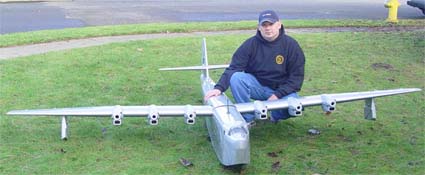
If any of your members have any interest in large-scale electric flying boats, here's Perry Fernau's thread on (what used to be my) B&V-238: www.rcgroups.com/forums/showthread.php?t=1357582
Cheers, and happy holidays!
David Plummer
Bellevue, WA
Return to "What's In This Issue"
The January EFO Meeting
Because of 'bad' weather on January 12, the meeting was delayed a week. The meeting was held at Ken Myers' house, and it was a good one!
Denny Sumner lead off with a show and tell on his nearly completed standoff scale Tipsy. Denny designed the planes for this scale model. It has approximately 355 sq.in. of wing area. It should weigh about 35 oz. to 36 oz. ready to fly. The power system consists of a Scorpion S-3008-32 outrunner and a 3S 2100mAh or 2200mAh Li-Poly battery.
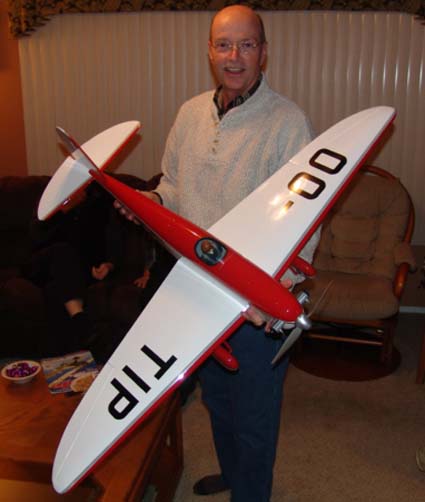
Denny has a build thread on RC Groups concerning the designing and construction of this great looking model. www.rcgroups.com/forums/showthread.php?t=1330614
It is beautifully finished in red Monokote and white Ultracote. The graphics were provided by Callie Graphs. (www.callie-graphics.com)
Richard Utkan, EFO vice-president, had a plane and new electronic device to share. The plane is called the Simple Corsair. Richard found the plans on RC Groups. www.rcgroups.com/forums/showthread.php?t=479524
He's been having a lot of fun flying it low and slow at the Ultimate Soccer Arenas in Pontiac.
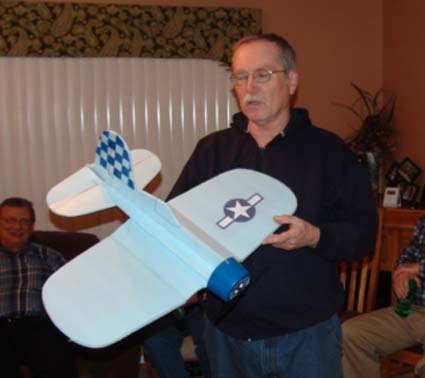
He made several modifications to the original. He used dowel instead of the more expensive carbon fiber whenever possible. His improvised cowl is made from the bottom of a Yogurt container. The wing is a KFm type. The motor is a Turnigy 2730-1300Kv outrunner.
center>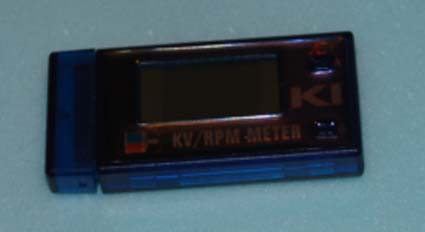
He also brought along his new Kv meter. It is called the AEO-RC Motor KV/RPM Digital Meter. The meter appears to be manufactured by Aero Electronics Operations(AEO Tech). www.aeorc.com/english/?product-277.html
It appears to be rebranded by Hobby King. www.hobbyking.com/hobbyking/store/uh_viewitem.asp?idproduct=10335
Richard purchased his from HobbyPartz. www.hobbypartz.com/88e-aekm200-k1-kv-meter.html.
He brought along a 3S Li-Poly and servo driver and we tested the Kv of a Turnigy 2730-1300 and found the Kv to be 1515 RPM/v.
Bill Brown shared a new Li-Poly safety bag that he purchased at Nankin Hobby in Farmington, MI. We discussed safety charging bags in general and whether this was a decent one or not. Jim Cross said that he did find information about BillÕs bag online, and that it seems that it should work. It was also mentioned that the LipoSack has a proven track record and an excellent guarantee. The real LipoSack guarantee reads, "If your LipoSack is involved in an ignition resulting in a venting of the battery and fire send us an email at sales@liposack.com with a statement of the circumstances and receive a replacement LipoSack free of charge!" www.liposack.com/productinfo.htm
We also discussed whether home 'fire safe' containers make a decent storage vessel for Li-Poly batteries. Several people noted that they generally have a 'plastic' interior that might melt or ignite as well.
Ken Myers did a presentation on his new 'winter' building project. He shared, via video presentation, a lot of information about the proposed model, an Antonov An-2, and the full-scale plane. He talked a lot about the trials and tribulations of trying to get this project off the ground. There is a very good reason that this HUGE biplane is seldom modeled. It is a bear to try and figure out how to do it well!
He showed the mockup of the top wing attachment for his An-2 and described the problems involved in getting the wing 'above' the fuselage, yet still attached to it!
Ken also showed his new
Multi-Charge Cable from Progressive RC.

He also shared and displayed the DVD disks of Model Builder magazine. (
The group then enjoyed some light refreshments and general electric flight chatting. It was a great night.
Anyone with an interest is always welcome. The next EFO meeting is scheduled for Wednesday, February 9, 7:30 p.m., at Ken Myers' house in Commerce Twp., MI.
Return to "What's In This Issue"
Ken Myers' Antonov An-2 Project
Near the end of October I started to think about my winter building project. I had had a lot of fun with my Super Stearman and decided that I wanted another biplane. I wanted something a little different and remembered a huge Russian biplane I'd seen at Kermit Weeks' Fantasy of Flight in Polk City, FL. www.fantasyofflight.com The plane was the HUGE Antonov An-2.
It met the criteria of being different, as I'd never seen one modeled before. Then I realized that I like to fly my planes in a scale like manner and a big, STOL utility plane only takes off from point A and flies its passengers or cargo to a short field destination point B. How much fun would that be at the RC field?
I did a lot of research on the Internet and found a video of a Polish pilot flying an An-2 and doing aerobatics including stall turns, loops and a show pass. www.youtube.com/watch?v=5VKjPf1SjpI
I also found another aerobatic video with 'smoke on.' www.youtube.com/watch?v=iFjLIju2zqQ
During my Internet research I found a photo of an An-2 that had been modeled in England in 1995 by Don Luck. When I saw a photo of the model, that sealed the deal. The full-scale is/was sponsored by Utterly Butterly, a table spread over there.
Don's model used a .19 to .25-glow 2-stroke and in the small photo that I found on the Internet, looked intriguing. It was definitely the right colors!
On November 10, I ordered the plans and asked for a copy of the construction article as I thought that there would be some good ideas that I could incorporate into my model.
The article showed up near the end of December, and proved to be disappointing. It is really more "cartoon" scale than semi-scale. The plans have still not shown up yet, which really doesn't matter, as they'll be quite useless when they do.
The one good thing about the article was that there were six photos of the full-scale "Utterly Butterly".
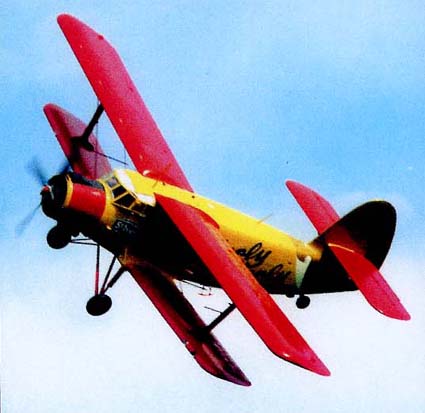
Full Scale Utterly Butterly
I continued my research on the Internet and gathered as many line draws as I thought might be useful. I started to create a 5-view on December 22 using the various views and thought that I had a workable 5-view by the end of December.
Unfortunately, I had made a HUGE mistake in the shape of the wing at the top of the fuselage on my 5-view. This was to cause me endless headaches for many weeks.
Using the Internet, I continued to gather photos of the plane and close-ups of the details that I would need to model my standoff scale version.
While "Utterly Butterly" was my 'first love', I ran across LY-ABK.
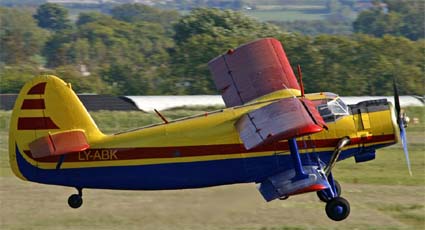
It is registered in Lithuania and flown by a Swedish pilot. The sponsor is Aeroseum in Sweden. Aeroseum is an aircraft museum located inside a declassified Swedish Air Force bunker carved out of solid rock.
www.aeroseum.se/english/index.html
During my Internet research, I had also gathered information on the specifications for this aircraft type from several sites.
en.wikipedia.org/wiki/Antonov_An-2
www.an2flyers.org
www.yakuk.com/AN2.asp
www.wordiq.com/definition/Antonov_An-2
and one site I forgot to note the URL of
Engine photos and prop data: www.an2flyers.org/engine.html
As with all things on the Internet, the data did not match. I created a spreadsheet of the data so that I could see side-by-side the similarities and differences. The following is what I'm using as the specifications for the type.
Antonov An-2 Specifications
Primary Function: STOL utility
Crew: one or two
Capacity: 12 passengers
Length: 40' 8"
Wingspan
Upper: 59' 8"
Lower: 46' 9"
Height: 13'
Wing Area: 770 sq.ft.
Empty weight: 7,600 lb.
Loaded weight: 12,125 lb.
Maximum fuel weight: 1984.2 lb.
Useful load: 4500 lb.
Power Plant: Shvetsov (aka Shoetson) ASh-62R 9-cylinder supercharged radial engine, 750 kW (1,000 hp)
Maximum Speed: 160 mph
Cruise Speed: 110 mph to 120 mph
Stall Speed: 30 mph to 56 mph
Range: 525 miles
Service Ceiling: 14,750 ft.
Rate of Climb: 700 ft./min.
Power/Mass Maximum Loaded Weight: 61.5 watts/lb.
Power/Mass with pilot and 1/2 fuel load (aka Airshow flying) 8800 lb: 84.7 watts/lb.
Propeller: 11' 9 3/4"
First Flight: Aug. 31, 1947
Year Deployed: 1948
Selecting the Scale
My original thought was to make it as large as I could and still the fuselage into the back of my Subaru Outback.
On December 30, I talked with Keith Shaw about the project and some of its pitfalls, especially the top wing connection. He suggested that I make the bottom wing one piece and use the rigging and interplane struts to actually hold and brace the upper wing.
Following Keith's suggestion, the bottom wingspan became the determining factor for the scaling.
I created a spreadsheet that shows the scaling from 1/3-scale through 1/14-scale and included the "oddball" 1/8.7-scale, as that is what my Super Stearman is. After a lot of consideration and debate with myself, I settled on 1/9-scale. 1/9-scale is close enough to the Super Stearman's scale so that when they are on the field together, I can note that they are built to approximately the same scale. The An-2 will kind of dwarf the Super Stearman. At 1/9-scale the bottom wing has a span of 62.13" and will fit as one piece in my Outback.
Several other calculations were made regarding cubic wing loading for biplanes in general and I set my target weight at 11.5 lb. This also allowed me to select my power system.
My proposed model based on my 5-view and spreadsheet calculations:
Top wingspan: 79.14"
Top wing chord: Root 10.59" Tip 10.71"
Bottom wingspan: 62.13"
Bottom wing chord: 9.16"
Total wing area: 1407.74 sq.in.
Horizontal Stab span: 31.64"
Horizontal Stab chord: 8.04"
Horizontal Stab area: 242.42 sq.in.
Fuselage length: 53.01"
Fuselage length w/prop and spinner: 55.2"
Prop height w/tail wheel on ground: 20.46"
Vertical fin height w/tail wheel on ground: 18.42"
Main wheel(s) diameter: 3.5"
Tail wheel diameter: 2"
Prop diameter: 16"
Weight at 5 oz./cu.ft.: 152.83 oz./9.55 lb. (maybe minimum)
Weight at 7 oz./cu.ft.: 213.96 oz./13.37 lb. (hopefully not this high!)
Weight at 6 oz./cu.ft.: 183.4 oz./11.46 lb. (target weight)
Input power: about 1000 watts
Watts per lb. 5 oz./cu.ft.: 104.7
Watts per lb. 7 oz./cu.ft.: 74.8
Watts per lb. 6 oz./cu.ft.: 87.3
Motor: Scorpion S-4035-250
Prop: APC 16x12E
ESC: HV ICE 60 with 2S "A123" receiver pack.
Battery: 10S "A123" 2300mAh
On January 8 I talked with Keith again about the top wing attachment, tail wheel bracket, rib spacing and more. He provided a lot of very useful information and I could now get started on turning t he 5-view into actual plans.
Getting the Plans Started
I opened the 5-view, increased its size appropriately and started the actual plans by filling in the structure. As I mentioned earlier, I'd made a big mistake on the shape of the wing on top of the fuselage. This caused endless problems.
I had seen the plans for an An-2 on RC Groups in the Giants area. www.rcgroups.com/forums/showthread.php?t=1356346
The plans were created by a member known as long-1957, who appears to be Chinese. He created them using a 3D modeling program. They were impressive, but after viewing many photos of the full-scale plane, I could see some areas that just werenÕt correct, including the wing over part of the fuselage area.
As I drew up the fuselage cross member stations for the area of the wing above the fuselage, I became more and more confused. I decided that I needed to build a mockup to see what exactly was going on.
I started the mockup on January 15 and finished it on January 19. It was four days of fit, try, redo, reprint and endless trips from the dining room to the basement and back.
I created a 'laundry list' of things that need to be modified on the plans. The most important thing that happened was that I was 'forced' to revisit the line drawings of the top view and FINALLY noticed the actual shape of the wing over the fuselage at the leading edge.
The mockup was constructed of Foamboard and balsa, all of which I had on hand. The three-dimensional form of what was happening really helped a lot.
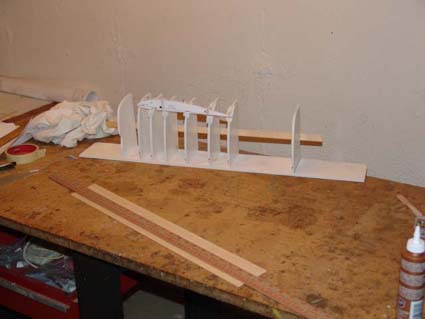
Fuselage cross-section stations made of Foamboard were glued to a Foamboard base. The rib attached to the fuselage was glued on.
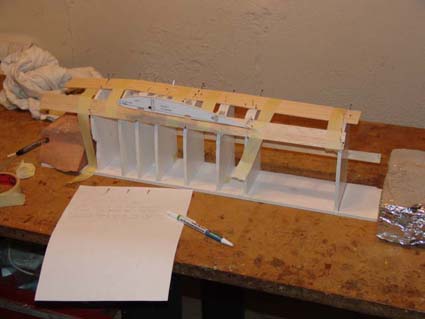
Some 1/16" balsa sheeting was applied to the fuselage.
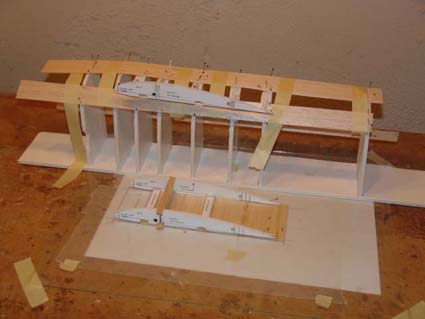
An inboard section of wing was created to mate to the fuselage.
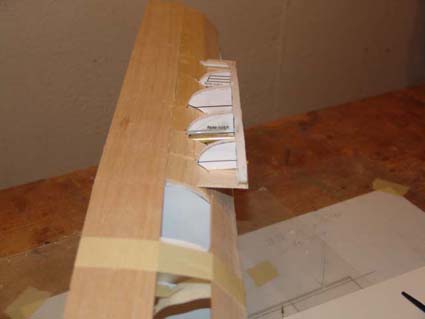
The rest of the fuselage was sheeted through the wing area. That is when it became really apparent that the wing area above the fuselage was drawn incorrectly, and that's when I went back to the original top view and discovered the problem. The former closest to the camera is the wrong shape and should go deeper 'into' the fuselage, like the former behind it.
I redrew the former and added it to the existing former.
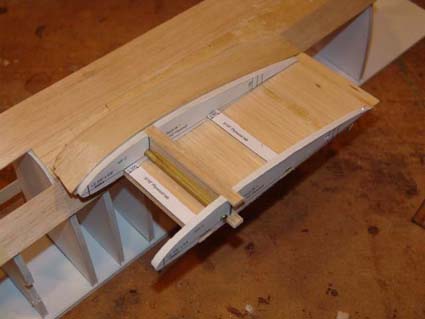
That troublesome area now has the correct shape.
The mockup showed that several changes needed to be made to the wing design as well as the bottom of the wing attachment area.
The mockup was definitely worth the 5 days of work.
Now it is onward with the plans!
Return to "What's In This Issue"
Put This One On Your Event Schedule!
Keith Shaw Birthday Party Electric Fly-In
From Dave Grife grifesd@yahoo.com
The Balsa Butchers will once host the "Keith Shaw Birthday Party Electric Fly-In" at their field near Coldwater, MI. This is the 10th Anniversary of this event. The event will take place on June 4 and 5, 2011.
Contest Director: Dave Grife - E-mail:
grifesd@yahoo.com or Phone: 517.279.8445
Please e-mail or call with any questions
The Flying Field will be open Friday, June 3 for early arrivals
Saturday, June 4, hours are from 9 a.m. 'til 5 p.m.
Sunday, June 5, hours are form 9 a.m. 'til 3 p.m.
Landing Fee is $10 for the weekend.
Directions: Quincy is approximately 4.5 miles east of I-69. Clizbe Road is approximately 1.6 miles east of Quincy. The Flying site is approximately 1.5 miles south of US-12 on the west side of Clizbe Road.
| 













